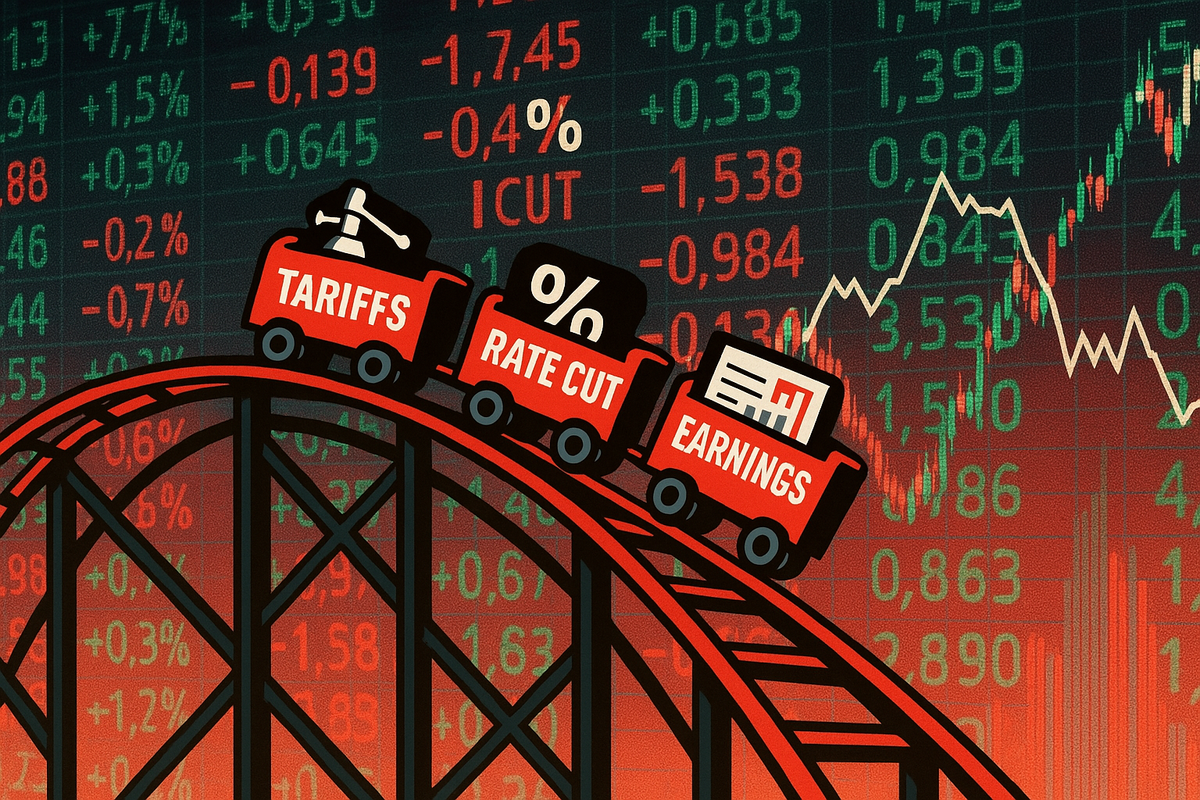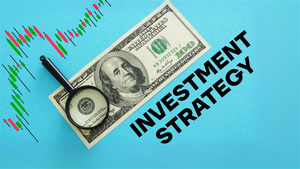Financial News
Mid-2025 Market Rollercoaster: Tariffs, Rate Cuts, and Resilient Earnings Shape a Volatile Landscape

Mid-2025 has proven to be a period of intense volatility and significant shifts in the global financial markets, characterized by a dramatic tariff-induced stock market crash, the Federal Reserve's cautious dance with interest rate cuts, concerning U.S. jobs data, and a surprisingly robust corporate earnings season. These disparate forces have collectively painted a complex picture for investors, highlighting both the fragility of global trade relations and the underlying resilience of corporate America. The immediate implication is a market grappling with uncertainty, where economic fundamentals are constantly re-evaluated against geopolitical headwinds and monetary policy expectations.
A Tumultuous Ride: Tariffs, Data, and the Fed's Dilemma
The mid-2025 market narrative began with a seismic shock in April, when new tariff policies sent global equities spiraling. On April 2, 2025, United States President Donald Trump's announcement of sweeping new tariff policies, dubbed "Liberation Day," triggered widespread panic selling. These tariffs, designed to impact nearly all sectors of the U.S. economy and escalating trade wars with major partners like China, Canada, and Mexico, led to immediate and severe market reactions. The S&P 500 (^GSPC), Nasdaq Composite (^IXIC), and Dow Jones Industrial Average (^DJI) experienced substantial declines, with the S&P 500 recording its worst two-day performance ever. Oil prices also plummeted. The initial 10% universal tariff on nearly all U.S. imports took effect on April 5. However, in a swift response to the market turmoil, the Trump administration announced a 90-day pause on most tariff increases on April 9, which remarkably spurred a significant stock market rally. By May 13, the S&P 500 had turned positive for the year, and by June 27, both the S&P 500 and Nasdaq closed at all-time highs, showcasing an extraordinary recovery from the initial crash.
Amidst this trade-induced volatility, the Federal Reserve's monetary policy remained a central focus. After implementing 1 percentage point in rate cuts from September to December 2024, bringing the federal-funds rate to 4.25%-4.50%, the Fed maintained a holding pattern through the first half of 2025. Despite persistent calls from President Trump for immediate rate cuts, the Fed initially held off, with some members expressing concerns about potential tariff-related inflation. However, the landscape shifted dramatically with the release of unexpectedly weak U.S. jobs data in August 2025. The July jobs report revealed that U.S. employers added only 73,000 jobs, significantly below expectations. More alarmingly, substantial downward revisions to May and June payrolls shaved a staggering 258,000 jobs off previously reported figures. The unemployment rate also ticked up to 4.2% in July from 4.1% in June. This weak report intensified pressure on the Federal Reserve to cut interest rates, with market participants by early August anticipating at least two cuts by the end of 2025. Federal Reserve officials, including San Francisco Federal Reserve President Mary Daly, signaled that rate cuts might commence soon due to the weakening labor market and stable inflation.
Despite the macroeconomic headwinds, the corporate earnings season in mid-2025 provided a surprising beacon of strength. Q1 2025 earnings were generally positive, with S&P 500 earnings growing by a robust +10% overall, and +13% compared to the same quarter a year ago, exceeding expectations by nearly +6%. Every S&P 500 sector reported actual results that beat estimates at the end of Q1. Much of this strength was attributed to large technology firms, particularly those heavily invested in artificial intelligence, which continued to benefit from strong demand. Companies like NVIDIA (NASDAQ: NVDA), Microsoft (NASDAQ: MSFT), and Alphabet (NASDAQ: GOOGL) continued to demonstrate robust growth, driven by insatiable demand for AI infrastructure and services. Positive surprises were also observed in the industrials, healthcare, financials, and materials sectors, underscoring the resilience of corporate profits despite policy uncertainty and concerns about slowing economic growth. While Q2 earnings estimates saw some downward revisions, calendar year 2025 and 2026 earnings were still projected to remain positive, offering a counter-narrative to the broader economic anxieties.
Navigating the Crosscurrents: Winners and Losers Emerge
The mid-2025 market environment created distinct winners and losers. Companies with significant international supply chains or those heavily reliant on exports faced immediate headwinds from the new tariff policies. Manufacturers and agricultural businesses, particularly those with exposure to China, Canada, and Mexico, likely bore the brunt of the initial trade war escalation. Their profit margins were squeezed by increased import costs and reduced demand from retaliating nations. Conversely, domestic-focused companies with minimal international exposure might have been relatively insulated from the direct impact of tariffs, or even benefited from a potential shift towards domestic production, though the overall economic slowdown could still affect them.
The technology sector, particularly large technology firms involved in artificial intelligence (AI), emerged as a clear winner. Their strong Q1 earnings, which significantly contributed to the overall S&P 500 earnings growth, highlighted their resilience and continued market dominance. This suggests that even amidst broader economic concerns, transformative technological trends can create pockets of exceptional performance. Furthermore, sectors like healthcare, financials, and materials also showed surprising strength in their earnings, indicating a broader, albeit uneven, corporate health. Companies with strong balance sheets and diversified revenue streams were better positioned to weather the volatility, while those with high debt or concentrated market exposure faced greater risks.
Broader Implications: Trade, Policy, and Economic Health
The events of mid-2025 underscore several critical broader industry trends and implications. The swift market reaction to the tariff announcements highlighted the profound interconnectedness of the global economy and the market's extreme sensitivity to trade policy. It served as a stark reminder that geopolitical tensions can rapidly translate into significant financial instability. The subsequent partial reversal and market recovery also demonstrated the market's capacity for rapid adjustment and its tendency to price in policy changes quickly, especially when there's a perceived de-escalation. This period could set a precedent for how markets react to future trade disputes, potentially leading to more immediate and dramatic swings based on policy announcements.
The Federal Reserve's evolving stance on interest rates, influenced by both inflation concerns and weakening jobs data, signals a potential pivot in monetary policy. If the Fed proceeds with multiple rate cuts, it could provide a much-needed stimulus to the economy, potentially easing borrowing costs for businesses and consumers. However, it also raises questions about the underlying health of the U.S. economy, particularly if the jobs market continues to deteriorate. This situation draws parallels to previous periods where the Fed had to balance inflation control with economic growth support, such as during the early 2000s or post-2008 financial crisis. Regulatory bodies will likely scrutinize the impact of tariffs on specific industries and consumer prices, potentially leading to new policy discussions aimed at mitigating future trade-related shocks. The resilience of corporate earnings, especially in tech, suggests a growing divergence between the performance of innovative, high-growth sectors and more traditional, cyclical industries, which could influence investment strategies going forward.
What Comes Next: A Path Forward for Investors
Looking ahead, the stock market faces a period of continued re-evaluation. In the short term, all eyes will be on the Federal Reserve's next moves. The weak August jobs data has significantly increased the probability of a September rate cut, and subsequent cuts by year-end. Should the Fed indeed embark on an easing cycle, it could provide a tailwind for equities, particularly growth stocks, by making borrowing cheaper and potentially stimulating economic activity. However, investors will also be closely watching subsequent jobs reports and inflation data to gauge the true health of the economy and the pace of future rate cuts. Any further escalation or de-escalation in trade tensions will also remain a critical market driver, with sudden policy shifts capable of triggering rapid market reactions.
In the long term, companies will need to adapt their supply chain strategies to account for ongoing geopolitical risks and the potential for future tariff impositions. Diversifying manufacturing bases and sourcing materials from multiple regions could become a strategic imperative. For investors, this environment presents both challenges and opportunities. Sectors that are less exposed to trade wars and benefit from lower interest rates, such as technology and certain growth-oriented industries, might continue to outperform. Conversely, industries heavily reliant on global trade or sensitive to economic slowdowns may face continued headwinds. Strategic pivots towards more resilient business models and a focus on innovation will be key for corporate success. Potential scenarios range from a soft landing, where the Fed successfully engineers a mild slowdown without a recession, to a more challenging environment if trade wars intensify or the jobs market deteriorates further, potentially leading to a deeper economic contraction.
Conclusion: A Market in Flux, Demanding Vigilance
Mid-2025 has been a period of profound market transformation, marked by a sharp, tariff-driven downturn followed by a robust recovery fueled by strong corporate earnings. The subsequent weak jobs data in August then reignited concerns about the economy's health but simultaneously heightened expectations for Federal Reserve easing. The key takeaway is the market's remarkable resilience in the face of significant shocks, coupled with its acute sensitivity to both trade policy and monetary policy signals. Corporate profitability, particularly within the technology sector, has proven to be a crucial stabilizing force, demonstrating underlying strength even amidst broader economic anxieties.
Moving forward, the market will remain highly responsive to macroeconomic data, particularly employment figures and inflation reports, as these will dictate the Federal Reserve's path on interest rates. Investors should also remain vigilant regarding global trade developments, as sudden policy shifts can still trigger significant volatility. The interplay between a potentially slowing economy, an easing Federal Reserve, and resilient corporate earnings will define the market's trajectory in the coming months. Diversification, a focus on fundamentally strong companies, and a keen eye on both geopolitical developments and central bank communications will be paramount for navigating this complex and dynamic financial landscape. The lasting impact of this period will likely be a heightened awareness of systemic risks and a greater emphasis on adaptability in both corporate strategy and investment portfolios.
More News
View More





Quotes delayed at least 20 minutes.
By accessing this page, you agree to the following
Privacy Policy and Terms Of Service.



